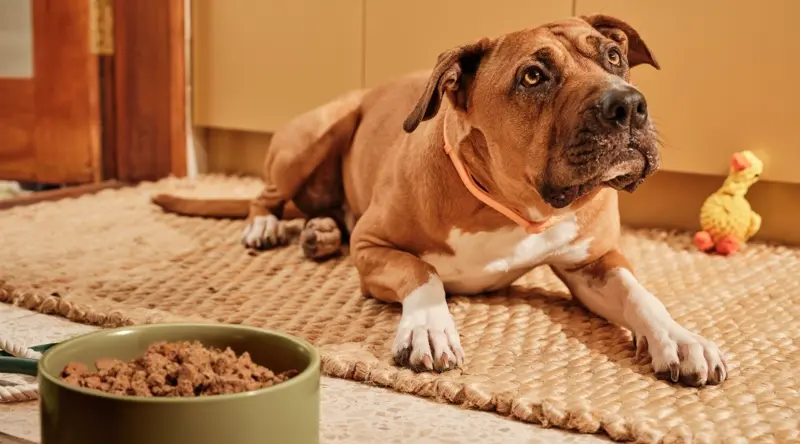Blue Heelers may be compact, but they pack the energy and intelligence of a true working dog. Bred to herd cattle under the harsh Australian sun, they thrive on challenge, purpose, and plenty of action. Without the right training and daily stimulation, though, that drive can quickly turn into mischief — and a few nipped ankles.
In this guide, we’ll unpack the Blue Heeler’s unique mindset and how to channel it into positive, purposeful behaviours. From smart training strategies to the role of balanced nutrition in keeping their focus razor-sharp, you’ll find everything you need to help your Heeler excel — at home and beyond.
Read more: Blue Heeler breed insights: care, personality & expert tips
Blue Heeler temperament and trainability
Driven, alert, and tenacious, Blue Heelers are natural learners — but they’re not pushovers. Their strong will and independent streak, honed from years of working autonomously in the field, mean they respond best to confident handlers who offer structure, consistency, and engagement.
They thrive on routine and love having a clear purpose. This makes them highly trainable, especially when their training feels like a game or a job. But without adequate mental and physical stimulation, Blue Heelers can become bored, destructive, or overly controlling.
But don’t be intimidated. With patience, positive reinforcement, and an outlet for their intelligence and energy, your Blue Heeler can become a focused, responsive, and loyal companion.
)
Health considerations that can affect training
Blue Heelers are generally robust, but a few health issues can impact their training:
Joint conditions like hip and elbow dysplasia can be common in Blue Heelers. In these conditions, the ball and socket of the joints don’t fit together properly. Instead of moving smoothly, they grind and rub, leading to inflammation, pain, and reduced mobility. Over time, this can result in arthritis or more severe damage.
Joint discomfort often shows subtly at first, like slower movement or hesitation during training — before becoming a more serious barrier to exercise and focus.
Try this:
Although you can’t change your dog’s genes, you can support joint health with ingredients containing anti-inflammatory and antioxidant properties like turmeric, ginger, and omega-3s from fish oil — found in Lyka meals.
Lyka’s Joint Supplement also contains active ingredients like Green-lipped mussels and curcumin extract to promote joint health.
Read more: Hip dysplasia: how your dog’s diet can help
Excess weight or obesity can put stress on joints, decrease motivation to exercise and impact your dog’s ability to focus during training. Excess weight can also affect mood, energy levels and overall health.
Try this:
Feeding a real food diet that’s high in protein and full of fresh low-glycaemic index ingredients can help your Blue Heeler stay lean and energised. Lyka meals are custom-portioned for your dog’s ideal weight, made with real food that supports a healthy metabolism and sustained energy.
Read more: Lyka's vet guide to healthy dog weight (with charts and video)
How real food fuels your Blue Heeler’s focus
Just like us, dogs learn best when they’re feeling healthy, balanced and energised. Diet plays a big role in your pup’s ability to focus, stay calm, and retain information.
Blue Heelers benefit from:
Steady energy sources like butternut squash and purple sweet potato, which have a low glycaemic load and help release energy slowly.
Essential fatty acids like DHA and EPA (omega-3s from fish, mussels, or fish oil) support brain health and development, memory, and learning.
Fresh, bioactive nutrients, from ingredients like blueberries and shiitake mushrooms, to support immunity, skin health, and overall wellbeing
“A fresh food diet packed with brain-boosting nutrients supports your dog’s ability to learn and adapt. Omega-3s, especially DHA, are critical for memory and cognitive function.”
– Dr Alex England, Lyka Veterinarian, BVetMed MANZCVS (Small Animal Veterinary Practice)
Learn more about Dr Alexander England and his veterinary experience.
All Lyka meals are formulated by Board-Certified Veterinary Nutritionists to provide complete and balanced nutrition for learning, growth, and everyday health.
Read more: What do Blue Heelers eat? Breed-specific nutrition tips
Read more: Fuelling your dog’s focus: how nutrition impacts your dog’s training
)
Exercise first for improved focus
Exercising your Blue Heeler before a training session gives them the chance to burn off excess energy and helps them settle into a more focused mindset.
Blue Heelers need significantly more exercise than many breeds. Ideal pre-training activities include:
Off-leash running or structured fetch
Herding-style games, frisbee or agility
A fast-paced walk or jog
Avoid overexertion in hot weather and always allow time for a cool-down before training.
Training tips for Blue Heelers
Training a Blue Heeler can be equal parts comedy and chaos — but with patience and a playful approach, it’s incredibly rewarding.
Keep sessions short, sweet, and full of positive vibes. Here’s what works best:
Positive reinforcement
This is the gold standard for training. Marking good behaviour with rewards like praise, affection, treats, or continued interaction, teaches your pup how to behave and supports a strong and positive relationship.
Double up on rewards to mark excellent responses from your Blue Heeler, like praise and a pat, or praise and a treat.
Find their favourite motivator
Discovering your pup’s hierarchy of high-value rewards is a great way to keep your Blue Heeler motivated. Is it a nibble of roast chicken, their favourite squeaky toy, or playtime with you?
Train at the right time
Sometimes dogs don’t have the energy or desire to learn, especially if they’re too tired, too full, or hot and bothered.
Mental enrichment through training can be tiring for dogs, so find the right time to train and stop if you notice your dog starting to lose focus or fatigue.
Stay consistent
Consistency is key to training. Not just in setting your expectations, but in using the same verbal and non-verbal cues.
Be playful and engaging
Dogs are sensitive souls that can pick up on your mood. Keep your sessions fun and your positive energy will be contagious.
Watch their body language
If your pup starts to show signs of stress or tiredness, give them a break. If they’ve reached saturation point, it can be counterproductive to persevere. You can always come back to the training at another point.
Training your Blue Heeler puppy
Blue Heeler puppies are bold, smart, and full of mischief — but don’t expect instant results. House training is a priority, followed by early socialisation and obedience basics like sit, stay, and come.
What works?
A regular toilet routine
Positive crate training for safe sleep and downtime
Early and controlled socialisation with people, dogs, environments, and new experiences
Blue Heelers are sensitive to harsh corrections, so stick with force-free methods that build trust and confidence.
)
Training your adult Blue Heeler
Just because your Blue Heeler’s out of puppyhood doesn’t mean the training stops. In fact, ongoing mental stimulation is essential to keep their mind sharp and behaviour balanced.
This might look like:
Reinforcing polite greetings at the door
Learning new tricks or games
Adjusting to life changes, like moving house
Training for mobility support, like using a ramp in senior years
Dogs have neuroplasticity, meaning their brains adapt and change, making them lifelong learners. Keep training light and engaging, and celebrate progress, no matter how small.
When to call in a trainer or behaviourist
Not sure if your Blue Heeler’s quirks are just stubbornness — or something deeper?
A trainer is your go-to for obedience, manners, and routine behaviours. A qualified behaviourist, on the other hand, is best for issues like:
Reactivity
Anxiety or phobias
Aggression
Resource guarding
They work closely with your vet to address underlying causes and create a tailored plan. The earlier you seek support, the easier it is to create lasting change.
“If training your dog is very challenging, it may be worth considering a trainer or a behaviourist. A trainer can help you identify what may be triggering their behaviour and show you how to help your dog cope in those situations. The solution may be as simple as reframing what we expect from our dogs and our behaviours around them.”
— Laura V, qualified dog behaviourist
New to Lyka? Let’s rethink dog food together
Training your Blue Heeler is a journey — one that requires consistency, creativity, and compassion. Whether you’re navigating house training with a stubborn puppy or teaching your senior dog new routines, every small win is a step toward a calmer, more connected life together.
And remember, a well-fed brain is a trainable brain. Supporting your Blue Heeler’s learning with fresh, real food meals helps unlock their full potential.
Lyka nourishes hundreds of Blue Heelers across Australia – from energetic pups to seniors in their golden years – they’re all thriving on Lyka.
)
)
)

)
)
)
)
)
